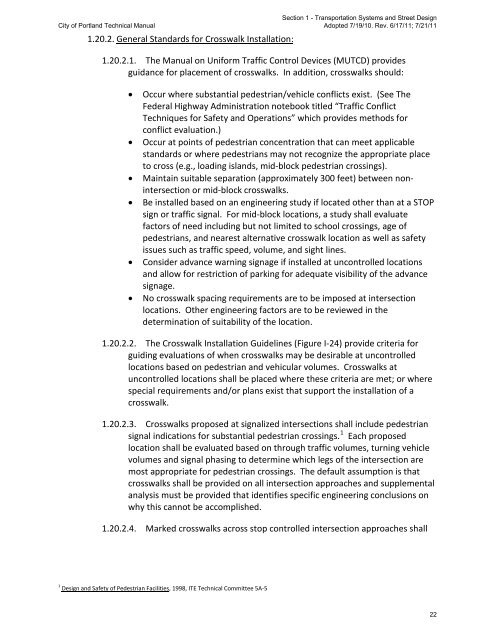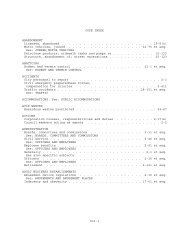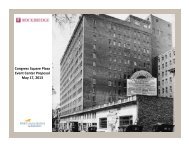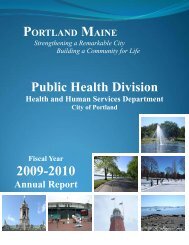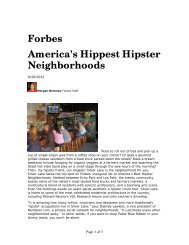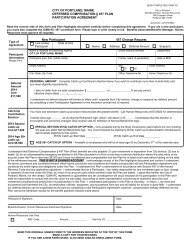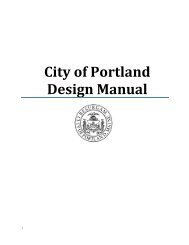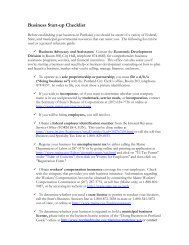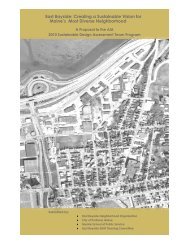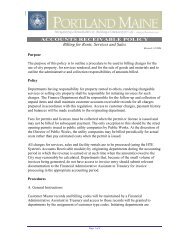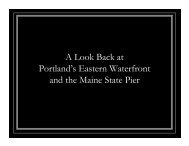City of Portland Technical Manual
City of Portland Technical Manual
City of Portland Technical Manual
You also want an ePaper? Increase the reach of your titles
YUMPU automatically turns print PDFs into web optimized ePapers that Google loves.
<strong>City</strong> <strong>of</strong> <strong>Portland</strong> <strong>Technical</strong> <strong>Manual</strong><br />
1.20.2. General Standards for Crosswalk Installation:<br />
Section 1 - Transportation Systems and Street Design<br />
Adopted 7/19/10. Rev. 6/17/11; 7/21/11<br />
1.20.2.1. The <strong>Manual</strong> on Uniform Traffic Control Devices (MUTCD) provides<br />
guidance for placement <strong>of</strong> crosswalks. In addition, crosswalks should:<br />
• Occur where substantial pedestrian/vehicle conflicts exist. (See The<br />
Federal Highway Administration notebook titled “Traffic Conflict<br />
Techniques for Safety and Operations” which provides methods for<br />
conflict evaluation.)<br />
• Occur at points <strong>of</strong> pedestrian concentration that can meet applicable<br />
standards or where pedestrians may not recognize the appropriate place<br />
to cross (e.g., loading islands, mid-block pedestrian crossings).<br />
• Maintain suitable separation (approximately 300 feet) between nonintersection<br />
or mid-block crosswalks.<br />
• Be installed based on an engineering study if located other than at a STOP<br />
sign or traffic signal. For mid-block locations, a study shall evaluate<br />
factors <strong>of</strong> need including but not limited to school crossings, age <strong>of</strong><br />
pedestrians, and nearest alternative crosswalk location as well as safety<br />
issues such as traffic speed, volume, and sight lines.<br />
• Consider advance warning signage if installed at uncontrolled locations<br />
and allow for restriction <strong>of</strong> parking for adequate visibility <strong>of</strong> the advance<br />
signage.<br />
• No crosswalk spacing requirements are to be imposed at intersection<br />
locations. Other engineering factors are to be reviewed in the<br />
determination <strong>of</strong> suitability <strong>of</strong> the location.<br />
1.20.2.2. The Crosswalk Installation Guidelines (Figure I-24) provide criteria for<br />
guiding evaluations <strong>of</strong> when crosswalks may be desirable at uncontrolled<br />
locations based on pedestrian and vehicular volumes. Crosswalks at<br />
uncontrolled locations shall be placed where these criteria are met; or where<br />
special requirements and/or plans exist that support the installation <strong>of</strong> a<br />
crosswalk.<br />
1.20.2.3. Crosswalks proposed at signalized intersections shall include pedestrian<br />
signal indications for substantial pedestrian crossings. 1 Each proposed<br />
location shall be evaluated based on through traffic volumes, turning vehicle<br />
volumes and signal phasing to determine which legs <strong>of</strong> the intersection are<br />
most appropriate for pedestrian crossings. The default assumption is that<br />
crosswalks shall be provided on all intersection approaches and supplemental<br />
analysis must be provided that identifies specific engineering conclusions on<br />
why this cannot be accomplished.<br />
1.20.2.4. Marked crosswalks across stop controlled intersection approaches shall<br />
1 Design and Safety <strong>of</strong> Pedestrian Facilities, 1998, ITE <strong>Technical</strong> Committee 5A-5<br />
22


